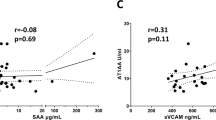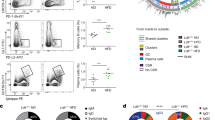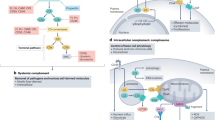Abstract
Aim:
To investigate the association between autoantibodies against angiotensin AT1 receptor (AT1-AAs) and endothelial dysfunction in vivo.
Methods:
Rat models with AT1 receptor antibodies (AT1-Abs) were established by active immunization for nine months. Lactate dehydrogenase (LDH) activity was regarded as an indicator of cell necrotic death. Endothelin-1 (ET-1) in the sera of rats was determined and endothelium-dependent vasodilatation was detected in isolated thoracic aorta. Endothelial intercellular adhesion molecule-1 (ICAM-1) expression in aorta endothelium was assessed using confocal microscopy. Coronary artery endothelial ultrastructure was observed.
Results:
IgGs in the immunized group significantly increased the LDH activity (0.84±0.17 vs 0.39±0.12, P<0.01 vs vehicle group IgGs)in incubated human umbilical vein endothelial cells through AT1 receptor. Higher content of ET-1 occurred in the immunized rats than that of the vehicle group, and reached two peaks at month 3 (27±4 ng/L, P<0.01) and month 7 (35±5 ng/L, P<0.01), respectively. In addition, aortic endothelium-dependent vasodilatation was attenuated; endothelial ICAM-1 level was markedly increased and cardiac capillary endothelium was damaged following immunization.
Conclusion:
Our study demonstrated that AT1-Abs contributed to endothelial dysfunction in vivo, which was a potential mechanism through which the antibodies play vital roles in related diseases.
Similar content being viewed by others
Log in or create a free account to read this content
Gain free access to this article, as well as selected content from this journal and more on nature.com
or
References
Kim S, Iwao H . Molecular and cellular mechanisms of angiotensin II-mediated cardiovascular and renal diseases. Pharmacol Rev 2000; 52: 11–34.
Roberts JM . Angiotensin-1 receptor autoantibodies: a role in the pathogenesis of preeclampsia? Circulation 2000; 101: 2335–7.
Fleming S . Malignant hypertension - the role of the paracrine renin-angiotensin system. J Pathol 2000; 192: 135–9.
Wallukat G, Homuth V, Fischer T, Lindschau C, Horstkamp B, Jupner A, et al. Patients with preeclampsia develop agonistic antibodies against the angiotensin AT1 receptor. J Clin Inves 1999; 103: 945–52.
Nakashima H, Suzuki H, Ohtsu H, Chao JY, Utsunomiya H, Frank GD, et al. Angiotensin II regulates vascular and endothelial dysfunction: recent topics of angiotensin II type-1 receptor signaling in the vasculature. Curr Vasc Pharmacol 2006; 4: 67–78.
Liao YH, Wei YM, Wang M, Wang ZH, Yuan HT, Cheng LX . Autoantibodies against AT1-receptor and alpha1-adrenergic receptor in patients with hypertension. Hypertens Res 2002; 25: 641–6.
Dragun D, Müller DN, Bräsen JH, Fritsche L, Nieminen-Kelhä M, Kintscher DR, et al. Angiotensin II type 1-receptor activating antibodies in renal-allograft rejection. N Engl J Med 2005; 352: 558–69.
Fu ML, Leung PS, Wallukat G, Bergström G, Fu H, Schulze W, et al. Agonist-like activity of antibodies to angiotensin II receptor subtype 1 (AT1) from rats immunized with AT1 receptor peptide. Blood Press 1999; 8: 317–24.
Sun YX, Zhang HY, Wei YM, Zhu F, Wang M, Liao YH . The mechanism of signal transduction during vascular smooth muscle cell proliferation induced by autoantibodies against angiotensin AT1 receptor from hypertension. Chin Med J (Engl) 2008; 121: 43–8.
Dechend R, Viedt C, Muller DN, Ugele B, Brandes RP, Wallukat G, et al. AT1 receptor agonistic antibodies from preeclamptic patients stimulate NADPH oxidase. Circulation 2003; 107: 1632–9.
Irani RA, Zhang Y, Zhou CC, Blackwell SC, Hicks MJ, Ramin SM, et al. Autoantibody-mediated angiotensin receptor activation contributes to preeclampsia through tumor necrosis factor-alpha signaling. Hypertension 2010; 55: 1246–53.
Bobst SM, Day MC, Gilstrap LC 3rd, Xia Y, Kellems RE . Maternal autoantibodies from preeclamptic patients activate angiotensin receptors on human mesangial cells and induce interleukin-6 and plasminogen activator inhibitor-1 secretion. Am J Hypertens 2005; 18: 330–6.
Chen Q, Chen L, Liu B, Vialli C, Stone P, Ching LM, et al. The role of autocrine TGFbeta1 in endothelial cell activation induced by phagocytosis of necrotic trophoblasts: a possible role in the pathogenesis of pre-eclampsia. J Pathol 2010 Jan 21. doi: 10.1002/path.2690.
Versari D, Daghini E, Virdis A, Ghiadoni L, Taddei S . Endothelium-dependent contractions and endothelial dysfunction in human hypertension. Br J Pharmacol 2009; 157: 527–36.
Suzuki H, Eguchi K, Ohtsu H, Higuchi S, Dhobale S, Frank GD, et al. Activation of endothelial nitric oxide synthase by the angiotensin II type 1 receptor. Endocrinology 2006; 147: 5914–20.
Newton CR, Curran B, Victorino GP . Angiotensin II type 1 receptor activation increases microvascular permeability via a calcium dependent process. J Surg Res 2005; 123: 33–9.
LaMarca B, Parrish M, Ray LF, Murphy SR, Roberts L, Glover P, et al. Hypertension in response to autoantibodies to the angiotensin II type I receptor (AT1-AA) in pregnant rats: role of endothelin-1. Hypertension 2009; 54: 905–9.
Yang X, Wang F, Chang H, Zhang S, Yang L, Wang X, et al. Autoantibody against AT1 receptor from preeclamptic patients induces vasoconstriction through angiotensin receptor activation. J Hypertens 2008; 26: 1629–35.
Korzeniewski C, Callewaert DM . An enzyme-release assay for natural cytotoxicity. J Immunol Methods 1983; 64: 313–20.
Vasudevan H, Nagareddy PR, John H . Gonadectomy prevents endothelial dysfunction in fructose-fedmale rats, a factor contributing to the development of hypertension. Am J Physiol Heart Circ Physiol 2006; 291: H3058–H3064.
Schulz E, Jansen T, Wenzel P, Daiber A, Münzel T . Nitric oxide, tetrahydrobiopterin, oxidative stress, and endothelial dysfunction in hypertension. Antioxid Redox Signal 2008; 10: 1115–26.
Houston MC . Nutraceuticals, vitamins, antioxidants, and minerals in the prevention and treatment of hypertension. Prog Cardiovasc Dis 2005; 47: 396–49.
Walsh SW . What causes endothelial cell activation in preeclamptic women? Am J Pathol 2006; 169: 1104–6.
Dechend R, Homuth V, Wallukat G, Kreuzer J, Park JK, Theuer J, et al. AT1 receptor agonistic antibodies from preeclamptic patients cause vascular cells to express tissue factor. Circulation 2000; 101: 2382–7.
Thway TM, Shlykov SG, Day MC, Sanborn BM, Gilstrap LC 3rd, Xia Y, et al. Antibodies from preeclamptic patients stimulate increased intracellular Ca2+ mobilization through angiotensin receptor activation. Circulation 2004; 110: 1612–9.
Fu ML, Leung PS, Wallukat G, Bergström G, Fu H, Schulze W, et al. Agonist-like activity of antibodies to angiotensin II receptor subtype 1 (AT1) from rats immunized with AT1 receptor peptide. Blood Press 1999; 8: 317–24.
Levin ER . Endothelins. N Engl J Med 1995; 333: 356–63.
Moldes O, Sobrino T, Millán M, Castellanos M, Pérez de la Ossa N, Leira R, et al. High serum levels of endothelin-1 predict severe cerebral edema in patients with acute ischemic stroke treated with t-PA. Stroke 2008; 39: 2006–10.
Ariza AC, Bobadilla NA, Halhali A . Endothelin 1 and angiotensin II in preeclampsia. Rev Invest Clin 2007; 59: 48–56.
Knock GA, Poston L . Bradykinin-mediated relaxation of isolated maternal resistance arteries in normal pregnancy and preeclampsia. Am J Obstet Gynecol 1996; 175: 1668–74.
Mizia-Steck K . Cytokines and adhesive molecules in detection of endothelial dysfunction. Pharmacol Rep 2006; 58 Suppl: 21–32.
Intengan HD, Schiffrin EL . Vasopeptidase inhibition has potent effects on blood pressure and resistance arteries in stroke-prone spontaneously hypertensive rats. Hypertension 2000; 35: 1221–5.
Qiu Y, Zhu F, Liao YH, Li ZZ, Wang M . Association between positive autoantibodies against AT1-receptor and cardiac remodeling in patients with hypertension. Zhonghua Xin Xue Guan Bing Za Zhi 2007; 35: 1141–4.
Jahns R, Boivin V, Hein L, Triebel S, Angermann CE, Ertl G, et al. Direct evidence for a β1-adrenergic receptor–directed autoimmune attack as a cause of idiopathic dilated cardiomyopathy. J Clin Invest 2004; 113: 1419–29.
Acknowledgements
This research is supported in part by grants from Key Laboratory of Medical Electrophysiological Open Foundation of Sichuan Province to Su-li ZHANG, Basic Research Project of Shanxi Province (2008011076-2) to Li-hong YANG, and NSFC (National Natural Science Foundation of China, 30900584) to Xiao-li YANG.
Author information
Authors and Affiliations
Corresponding author
Rights and permissions
About this article
Cite this article
Zhang, Sl., Du, Yh., Wang, J. et al. Endothelial dysfunction induced by antibodies against angiotensin AT1 receptor in immunized rats. Acta Pharmacol Sin 31, 1381–1388 (2010). https://doi.org/10.1038/aps.2010.144
Received:
Accepted:
Published:
Issue date:
DOI: https://doi.org/10.1038/aps.2010.144
Keywords
This article is cited by
-
Angiotensin type-1 receptor and ACE2 autoantibodies in Parkinson´s disease
npj Parkinson's Disease (2022)
-
Effect of photobiomodulation on endothelial cell exposed to Bothrops jararaca venom
Lasers in Medical Science (2016)
-
Autoantibodies Isolated from Preeclamptic Patients Induce Endothelial Dysfunction via Interaction with the Angiotensin II AT1 Receptor
Cardiovascular Toxicology (2014)
-
Frontiers of vascular biology and disease research
Acta Pharmacologica Sinica (2010)



